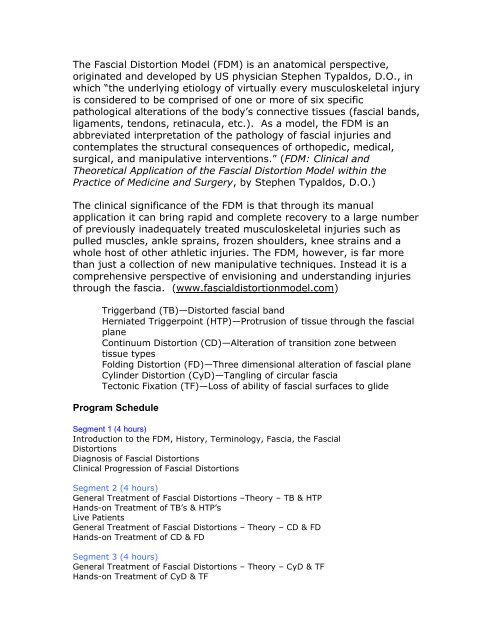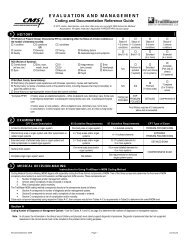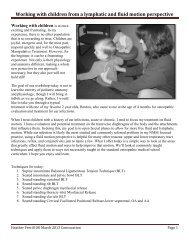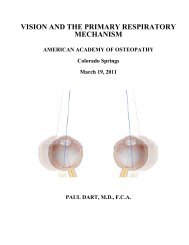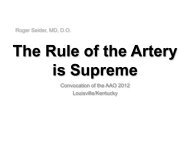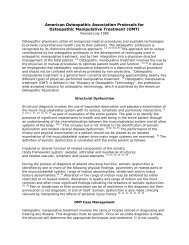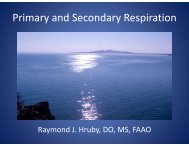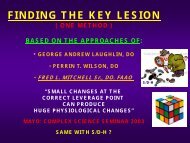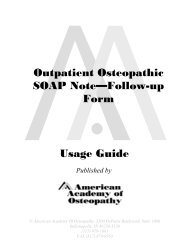Fascial Distortion Model - American Academy of Osteopathy
Fascial Distortion Model - American Academy of Osteopathy
Fascial Distortion Model - American Academy of Osteopathy
- No tags were found...
Create successful ePaper yourself
Turn your PDF publications into a flip-book with our unique Google optimized e-Paper software.
The <strong>Fascial</strong> <strong>Distortion</strong> <strong>Model</strong> (FDM) is an anatomical perspective,originated and developed by US physician Stephen Typaldos, D.O., inwhich “the underlying etiology <strong>of</strong> virtually every musculoskeletal injuryis considered to be comprised <strong>of</strong> one or more <strong>of</strong> six specificpathological alterations <strong>of</strong> the body’s connective tissues (fascial bands,ligaments, tendons, retinacula, etc.). As a model, the FDM is anabbreviated interpretation <strong>of</strong> the pathology <strong>of</strong> fascial injuries andcontemplates the structural consequences <strong>of</strong> orthopedic, medical,surgical, and manipulative interventions.” (FDM: Clinical andTheoretical Application <strong>of</strong> the <strong>Fascial</strong> <strong>Distortion</strong> <strong>Model</strong> within thePractice <strong>of</strong> Medicine and Surgery, by Stephen Typaldos, D.O.)The clinical significance <strong>of</strong> the FDM is that through its manualapplication it can bring rapid and complete recovery to a large number<strong>of</strong> previously inadequately treated musculoskeletal injuries such aspulled muscles, ankle sprains, frozen shoulders, knee strains and awhole host <strong>of</strong> other athletic injuries. The FDM, however, is far morethan just a collection <strong>of</strong> new manipulative techniques. Instead it is acomprehensive perspective <strong>of</strong> envisioning and understanding injuriesthrough the fascia. (www.fascialdistortionmodel.com)Triggerband (TB)—Distorted fascial bandHerniated Triggerpoint (HTP)—Protrusion <strong>of</strong> tissue through the fascialplaneContinuum <strong>Distortion</strong> (CD)—Alteration <strong>of</strong> transition zone betweentissue typesFolding <strong>Distortion</strong> (FD)—Three dimensional alteration <strong>of</strong> fascial planeCylinder <strong>Distortion</strong> (CyD)—Tangling <strong>of</strong> circular fasciaTectonic Fixation (TF)—Loss <strong>of</strong> ability <strong>of</strong> fascial surfaces to glideProgram ScheduleSegment 1 (4 hours)Introduction to the FDM, History, Terminology, Fascia, the <strong>Fascial</strong><strong>Distortion</strong>sDiagnosis <strong>of</strong> <strong>Fascial</strong> <strong>Distortion</strong>sClinical Progression <strong>of</strong> <strong>Fascial</strong> <strong>Distortion</strong>sSegment 2 (4 hours)General Treatment <strong>of</strong> <strong>Fascial</strong> <strong>Distortion</strong>s –Theory – TB & HTPHands-on Treatment <strong>of</strong> TB’s & HTP’sLive PatientsGeneral Treatment <strong>of</strong> <strong>Fascial</strong> <strong>Distortion</strong>s – Theory – CD & FDHands-on Treatment <strong>of</strong> CD & FDSegment 3 (4 hours)General Treatment <strong>of</strong> <strong>Fascial</strong> <strong>Distortion</strong>s – Theory – CyD & TFHands-on Treatment <strong>of</strong> CyD & TF
Diagnosis and Treatment <strong>of</strong> Shoulder Conditions According to the FDMTreatment <strong>of</strong> Shoulder Conditions PracticumLive PatientsSegment 4 (4 hours)Diagnosis and Treatment <strong>of</strong> Sprained Ankles According to the FDM –TheoryTreatment <strong>of</strong> Ankle Sprains PracticumLive Patients followed by discussion <strong>of</strong> treatmentsSegment 5 (4 Hours)Diagnosis and Treatment <strong>of</strong> Knee Conditions According to the FDMTreatment <strong>of</strong> Knee Conditions PracticumLive patient followed by discussion <strong>of</strong> treatmentQuestions, wrap-upBreaks to be inserted as needed.


